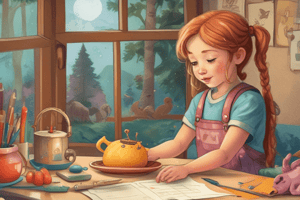Podcast
Questions and Answers
What are infants primarily using to relate to the world during the sensorimotor stage?
What are infants primarily using to relate to the world during the sensorimotor stage?
- Logical reasoning
- Sensory experiences (correct)
- Mathematical calculations
- Verbal communication
What concept develops as infants realize objects continue to exist even when out of sight?
What concept develops as infants realize objects continue to exist even when out of sight?
- Object permanence (correct)
- Separation anxiety
- Egocentrism
- Symbolic thought
During which stage do infants begin to identify themselves as separate entities from objects?
During which stage do infants begin to identify themselves as separate entities from objects?
- Sensorimotor stage (correct)
- Concrete operational stage
- Preoperational stage
- Formal operational stage
What kind of thought is characterized by the inability to think logically about objects and events?
What kind of thought is characterized by the inability to think logically about objects and events?
What type of thinking involves using trial and error to explore new characteristics of objects?
What type of thinking involves using trial and error to explore new characteristics of objects?
Separation anxiety typically begins to manifest in infants between what ages?
Separation anxiety typically begins to manifest in infants between what ages?
What is the primary characteristic of magical thinking in children?
What is the primary characteristic of magical thinking in children?
What cognitive development concept involves thinking that is often based on perceptions rather than logic?
What cognitive development concept involves thinking that is often based on perceptions rather than logic?
At what age do children typically first grasp the concept of conservation of numbers?
At what age do children typically first grasp the concept of conservation of numbers?
Which stage of cognitive development introduces children to the use of symbols?
Which stage of cognitive development introduces children to the use of symbols?
Which reasoning method describes a school-aged child's thought process when deducing that a broken toy made of plastic implies all plastic toys break easily?
Which reasoning method describes a school-aged child's thought process when deducing that a broken toy made of plastic implies all plastic toys break easily?
Which cognitive ability initiates during adolescence, allowing for thinking about possibilities?
Which cognitive ability initiates during adolescence, allowing for thinking about possibilities?
What concept describes a child's understanding that the amount of liquid does not change when poured into a different container?
What concept describes a child's understanding that the amount of liquid does not change when poured into a different container?
What ability signifies a shift from concrete to abstract thought, which begins during adolescence?
What ability signifies a shift from concrete to abstract thought, which begins during adolescence?
According to Kohlberg's theory, what does moral development depend on?
According to Kohlberg's theory, what does moral development depend on?
Which cognitive concept allows school-aged children to recognize that water remains the same amount regardless of container changes?
Which cognitive concept allows school-aged children to recognize that water remains the same amount regardless of container changes?
What is a characteristic of intuitive thinking in preschoolers?
What is a characteristic of intuitive thinking in preschoolers?
What does the lack of conservation in preschoolers refer to?
What does the lack of conservation in preschoolers refer to?
How do preschoolers demonstrate magical thinking?
How do preschoolers demonstrate magical thinking?
Which of the following best describes object permanence in toddlers?
Which of the following best describes object permanence in toddlers?
What is a key aspect of preoperational thought in preschoolers?
What is a key aspect of preoperational thought in preschoolers?
What misconception do preschoolers often have when observing water poured from one glass to another?
What misconception do preschoolers often have when observing water poured from one glass to another?
During the stage of intuitive thinking, which conclusion might a preschooler likely make?
During the stage of intuitive thinking, which conclusion might a preschooler likely make?
How do preschoolers typically use assimilation during their play activities?
How do preschoolers typically use assimilation during their play activities?
Flashcards are hidden until you start studying
Study Notes
Toddler Development
- Toddlers explore object permanence and various toy functions.
- They complete their understanding of object permanence, meaning they understand that objects continue to exist even when they are out of sight.
- They start to use symbols to represent objects.
Preschooler Development
- Preschoolers enter the intuitive thinking stage of preoperational thought.
- They tend to focus on only one characteristic of an object at a time.
- They struggle with conservation, the ability to understand that physical properties remain constant despite changes in appearance.
- They struggle with reversibility, the ability to retrace steps and understand that actions can be reversed.
- Preschool thinking is influenced by role fantasy and wishful thinking.
- They engage in assimilation, fitting new information into existing ideas.
- They engage in magical thinking, believing that objects have thoughts and feelings.
School-Aged Child Development
- School-aged children enter the concrete operational thought stage.
- They begin to use practical solutions to everyday problems.
- They understand cause-and-effect relationships.
- They grasp the concept of conservation.
- They develop inductive reasoning, moving from specific observations to general conclusions.
Adolescent Development
- Adolescents enter the formal operational thought stage.
- They become capable of abstract thinking, considering possibilities beyond the immediate.
- They can use scientific reasoning and deductive reasoning, moving from general principles to specific applications.
Piaget's Stages of Cognitive Development
- Piaget defined four stages of cognitive development, within which children reorganize their thinking processes to become more like adult thinking.
The Infant
- Infants are in the sensorimotor stage, using senses and reflexes to interact with the world.
- They develop object permanence, the understanding that objects continue to exist when out of sight.
- They gain a concept of their own body as separate from objects.
- They develop the ability to recognize their parents as distinct from other adults.
- Mastering object permanence contributes to the development of trust and separation anxiety.
The Toddler
- Toddlers transition from the sensorimotor to the preoperational stage.
- They continue to explore through trial and error.
Studying That Suits You
Use AI to generate personalized quizzes and flashcards to suit your learning preferences.




